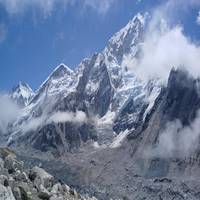Going to the base of Everest is more than a body trip — it's you putting money into one of the top things you'll ever do. Just thinking of being under the big top of the world's tallest hill is exciting. But first, you must plan your money well.
You don't need a lot of cash to go to the Everest Base Camp Trek Map. But you need to use your money well. Costs change a lot based on how you travel, the path you take, if you have a guide or go alone, and how you keep track of your spending. A good money plan makes your trip smooth and keeps away money issues when you get back.
Here's what you should know about the real costs of the trek — from flying and papers to eat and gear — and ways to save money without losing out on the fun.
Schenk uns bitte ein Like auf Facebook! #meinungsfreiheit #pressefreiheit
Danke!
Flying to Nepal
Your first big spend will be your flight to Kathmandu, the main city of Nepal. The cost depends a lot on the time, where you fly from, and how early you book. If flying from the US or Europe, costs are between $800 and $1,400 round-trip. It’s less from Asia or the Middle East.
Book early, pick a less busy time, or use flight price tools for cheaper options. Remember, big flights might not cover bag costs for your trek gear; add this to your budget.
Domestic Flights: Getting to Lukla
To begin the trek, most fly from Kathmandu to Lukla, a small town high up. This 30-minute flight is well-known as one of the maximum exciting. It commonly charges $three hundred to $four hundred round-trip. Costs alternate with demand and the time of the year.
The climate can put off flights, so add a day or two just in case.
Trek Papers and Costs
To go to Everest Base Camp, you need a couple of papers. One is the Khumbu Pasang Lhamu Rural Municipality, around NPR 2,000 ($15-$20). Every other is the Sagarmatha countrywide Park entry permit, round NPR three,000 ($25). These prices assist preserve the paths and guide natural work within the spot.
If you book via an agency, they cope with those; however, it’s proper to recognize and take a look at that they are protected.
Guided or Alone?
This is where your money can vary a lot. A guided trek gives ease, safety, and local insight but costs more — about $1,200 to $2,000 on average. Fancy options can go over $3,000.
Going alone may cost less — between $600 and $1,000 — but you plan everything yourself. Less cost but more work and more say in what you do. You can hire help as needed.
Stay and Eat on the Trek
You'll mostly sleep and eat in tea houses. Staying is cheap — often $5 to $10 a night. Some places let you stay for free if you eat all meals there.
Food gets pricey as you go higher. A dish of dal bhat might be $4 down low and $10 up high. Western food costs more. Plan about $20 to $30 each day for food and snacks.
High up, bottled water costs up to $3 per liter. Save cash and help the world with a reusable water bottle and a filter or tabs.
Gear
If you have trek gear, good. If not, you need good boots, a warm jacket, layers, poles, and a solid sleeping bag. All new can be $500 or more, but many shops in Kathmandu rent or sell used gear cheaply.
Final Words: Plan Smart, Use Money Wisely
Budgeting for Everest Base Camp Trek Itinerary is about balance. It's possible to do it without much money if you plan, spend smart, and know where cash goes. Whether with a full guide or in alone simple style, the best part is the trip — the price doesn’t match being under Everest’s great shadow.
When you think back on the trek, you won’t recall the spending on food or gear brands. You'll think of the people, hills, moments, and the joy of doing something awesome.
